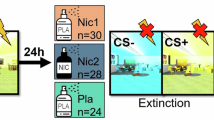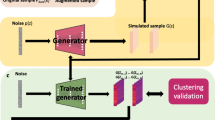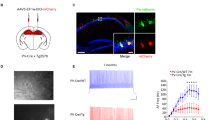Abstract
Addiction to nicotine and the inability to quit smoking are influenced by genetic factors, emphasizing the importance of understanding how genes and drugs of abuse mechanistically impact each other. One well-characterized protein responsible for regulating both response to drugs and gene expression is the transcription factor CREB (cAMP-responsive element binding protein). Previous work indicates that hippocampal-specific alterations in CREB signaling and synaptic plasticity may underlie certain nicotine withdrawal phenotypes. However, the structure of the hippocampus possesses dorsal and ventral subregions, each differing in behavioral, anatomic and gene expression characteristics. This study examines the effects of CREB deletion specifically in the ventral or dorsal hippocampus of animals chronically treated with saline, nicotine, or undergoing 24 h withdrawal. After region-specific viral injections of AAV-GFP or AAV-CRE in CREBloxP/loxP animals, behavioral testing measured anxiety levels, using the Novelty-Induced Hypophagia test, and cognition, using a contextual fear conditioning paradigm. Deletion of CREB in the ventral, but not dorsal, hippocampus resulted in amelioration of nicotine withdrawal-induced anxiety-like behavior in the Novelty-Induced Hypophagia test. In contrast, CREB deletion in the dorsal hippocampus resulted in learning and memory deficits in fear conditioning, whereas CREB deletion in the ventral hippocampus showed an enhancement in learning. Gene expression analysis showed differential treatment- and region-dependent alterations of several CREB target genes that are well-known markers of neuroplasticity within the hippocampus. Collectively, these data provide persuasive evidence towards the distinct roles of CREB within the dorsal and ventral hippocampus separately in mediating select nicotine withdrawal phenotypes.
Similar content being viewed by others
Log in or create a free account to read this content
Gain free access to this article, as well as selected content from this journal and more on nature.com
or
References
Bannerman DM, Deacon RM, Offen S, Friswell J, Grubb M, Rawlins JN (2002). Double dissociation of function within the hippocampus: spatial memory and hyponeophagia. Behavioral neuroscience 116: 884–901.
CDC (1988) The health consequeces of smoking: nicotine addiction: a report of the surgeon general. The Reports of the Surgeon General. Center for Health Promotion and Education, Office on Smoking and Health United States, Public Health Service, Office of the Surgeon General, 643.
Cearley CN, Wolfe JH (2006). Transduction characteristics of adeno-associated virus vectors expressing cap serotypes 7, 8, 9, and Rh10 in the mouse brain. Mol Ther 13: 528–537.
Cleck JN, Ecke LE, Blendy JA (2008). Endocrine and gene expression changes following forced swim stress exposure during cocaine abstinence in mice. Psychopharmacology 201: 15–28.
Costall B, Kelly ME, Naylor RJ, Onaivi ES (1989). The actions of nicotine and cocaine in a mouse model of anxiety. Pharmacol Biochem Behav 33: 197–203.
Davis JA, James JR, Siegel SJ, Gould TJ (2005). Withdrawal from chronic nicotine administration impairs contextual fear conditioning in C57BL/6 mice. J Neurosci 25: 8708–8713.
De Biasi M, Salas R (2008). Influence of neuronal nicotinic receptors over nicotine addiction and withdrawal. Exp Biol Med 233: 917–929.
Fanselow MS, Dong HW (2010). Are the dorsal and ventral hippocampus functionally distinct structures? Neuron 65: 7–19.
Ferbinteanu J, McDonald RJ (2001). Dorsal/ventral hippocampus, fornix, and conditioned place preference. Hippocampus 11: 187–200.
Froeliger B, Kozink RV, Rose JE, Behm FM, Salley AN, McClernon FJ (2010). Hippocampal and striatal gray matter volume are associated with a smoking cessation treatment outcome: results of an exploratory voxel-based morphometric analysis. Psychopharmacology 210: 577–583.
Gould TJ, Feiro O, Moore D (2004). Nicotine enhances trace cued fear conditioning but not delay cued fear conditioning in C57BL/6 mice. Behav Brain Res 155: 167–173.
Gould TJ, Wehner JM (1999). Nicotine enhancement of contextual fear conditioning. Behav Brain Res 102: 31–39.
Gundersen BB, Briand LA, Onksen JL, Lelay J, Kaestner KH, Blendy JA (2013). Increased hippocampal neurogenesis and accelerated response to antidepressants in mice with specific deletion of CREB in the hippocampus: role of cAMP response-element modulator tau. J Neurosci 33: 13673–13685.
Guzowski JF, Lyford GL, Stevenson GD, Houston FP, McGaugh JL, Worley PF et al (2000). Inhibition of activity-dependent arc protein expression in the rat hippocampus impairs the maintenance of long-term potentiation and the consolidation of long-term memory. J Neurosci 20: 3993–4001.
Huang EJ, Reichardt LF (2001). Neurotrophins: roles in neuronal development and function. Annu Rev Neurosci 24: 677–736.
Huff NC, Frank M, Wright-Hardesty K, Sprunger D, Matus-Amat P, Higgins E et al (2006). Amygdala regulation of immediate-early gene expression in the hippocampus induced by contextual fear conditioning. J Neurosci 26: 1616–1623.
Jackson KJ, Martin BR, Changeux JP, Damaj MI (2008). Differential role of nicotinic acetylcholine receptor subunits in physical and affective nicotine withdrawal signs. J Pharmacol Exp Ther 325: 302–312.
Kenney JW, Poole RL, Adoff MD, Logue SF, Gould TJ (2012). Learning and nicotine interact to increase CREB phosphorylation at the jnk1 promoter in the hippocampus. PLoS One 7: e39939.
Kim JJ, Jung MW (2006). Neural circuits and mechanisms involved in Pavlovian fear conditioning: a critical review. Neurosci Biobehav Rev 30: 188–202.
Kutlu MG, Gould TJ (2016). Effects of drugs of abuse on hippocampal plasticity and hippocampus-dependent learning and memory: contributions to development and maintenance of addiction. Learn Mem 23: 515–533.
Lenz B, Klafki HW, Hillemacher T, Killisch N, Schaller G, Frieling H et al (2010). Smoking behaviour is associated with expression and phosphorylation of CREB in human buffy coat. Int J Neuropsychopharmacol 13: 207–215.
Livak KJ, Schmittgen TD (2001). Analysis of relative gene expression data using real-time quantitative PCR and the 2(−Delta Delta C(T)) Method. Methods 25: 402–408.
Mansvelder HD, Keath JR, McGehee DS (2002). Synaptic mechanisms underlie nicotine-induced excitability of brain reward areas. Neuron 33: 905–919.
Martinowich K, Manji H, Lu B (2007). New insights into BDNF function in depression and anxiety. Nat Neurosci 10: 1089–1093.
Matta SG, Balfour DJ, Benowitz NL, Boyd RT, Buccafusco JJ, Caggiula AR et al (2007). Guidelines on nicotine dose selection for in vivo research. Psychopharmacology 190: 269–319.
McClernon FJ, Gilbert DG (2004). Human functional neuroimaging in nicotine and tobacco research: basics, background, and beyond. Nicotine Tob Res 6: 941–959.
Merali Z, Levac C, Anisman H (2003). Validation of a simple, ethologically relevant paradigm for assessing anxiety in mice. Biol Ppsychiatry 54: 552–565.
Morris RGM (1981). Spatial localization does not require the presence of local cues. Learn Motiv 12: 239–260.
Nestler EJ (2005). Is there a common molecular pathway for addiction? Nat Neurosci 8: 1445–1449.
Nishino Y, Tsuji I, Tanaka H, Nakayama T, Nakatsuka H, Ito H et al (2014). Stroke mortality associated with environmental tobacco smoke among never-smoking Japanese women: a prospective cohort study. Prev Med 67: 41–45.
Pandey SC, Roy A, Xu T, Mittal N (2001). Effects of protracted nicotine exposure and withdrawal on the expression and phosphorylation of the CREB gene transcription factor in rat brain. J Neurochem 77: 943–952.
Picciotto MR, Brunzell DH, Caldarone BJ (2002). Effect of nicotine and nicotinic receptors on anxiety and depression. NeuroReport 13: 1097–1106.
Pomerleau OF, Pomerleau CS, Mehringer AM, Snedecor SM, Ninowski R, Sen A (2005). Nicotine dependence, depression, and gender: characterizing phenotypes based on withdrawal discomfort, response to smoking, and ability to abstain. Nicotine Tob Res 7: 91–102.
Pothuizen HHJ, Zhang WN, Jongen-Relo AL, Feldon J, Yee BK (2004). Dissociation of function between the dorsal and the ventral hippocampus in spatial learning abilities of the rat: a within-subject, within-task comparison of reference and working spatial memory. Eur J Neurosci 19: 705–712.
Richmond MA, Yee BK, Pouzet B, Veenman L, Rawlins JN, Feldon J et al (1999). Dissociating context and space within the hippocampus: effects of complete, dorsal, and ventral excitotoxic hippocampal lesions on conditioned freezing and spatial learning. Behav Neurosci 113: 1189–1203.
Schwartz RD, Kellar KJ (1983). Nicotinic cholinergic receptor binding sites in the brain: regulation in vivo. Science 220: 214–216.
Suliman S, Hemmings SM, Seedat S (2013). Brain-derived neurotrophic factor (BDNF) protein levels in anxiety disorders: systematic review and meta-regression analysis. Front Integr Neurosci 7: 55.
Swanson LW, Cowan WM (1977). An autoradiographic study of the organization of the efferent connections of the hippocampal formation in the rat. J Comp Neurol 172: 49–84.
Tao X, Finkbeiner S, Arnold DB, Shaywitz AJ, Greenberg ME (1998). Ca2+ influx regulates BDNF transcription by a CREB family transcription factor-dependent mechanism. Neuron 20: 709–726.
Tiffany ST, Conklin CA, Shiffman S, Clayton RR (2004). What can dependence theories tell us about assessing the emergence of tobacco dependence? Addiction 99: 78–86.
Turner JR, Castellano LM, Blendy JA (2010). Nicotinic partial agonists varenicline and sazetidine—a have differential effects on affective behavior. J Pharmacol Exp Ther 334: 665–672.
Turner JR, Castellano LM, Blendy JA (2011). Parallel anxiolytic-like effects and upregulation of neuronal nicotinic acetylcholine receptors following chronic nicotine and varenicline. Nicotine Tob Res 13: 41–46.
Turner JR, Ray R, Lee B, Everett L, Xiang J, Jepson C et al (2014). Evidence from mouse and man for a role of neuregulin 3 in nicotine dependence. Mol Psychiatry 19: 801–810.
Turner JR, Wilkinson DS, Poole RL, Gould TJ, Carlson GC, Blendy JA (2013). Divergent functional effects of sazetidine-a and varenicline during nicotine withdrawal. Neuropsychopharmacology 38: 2035–2047.
Vincent AC, Struhl K (1992). ACR1, a yeast ATF/CREB repressor. Mol Cell Biol 12: 5394–5405.
Walker WH, Girardet C, Habener JF (1996). Alternative exon splicing controls a translational switch from activator to repressor isoforms of transcription factor CREB during spermatogenesis. J Biol Chem 271: 20145–21050.
Walters CL, Cleck JN, Kuo YC, Blendy JA (2005). Mu-opioid receptor and CREB activation are required for nicotine reward. Neuron 46: 933–943.
Wilkinson DS, Turner JR, Blendy JA, Gould TJ (2013). Genetic background influences the effects of withdrawal from chronic nicotine on learning and high-affinity nicotinic acetylcholine receptor binding in the dorsal and ventral hippocampus. Psychopharmacology 225: 201–208.
Acknowledgements
We thank Dr Julie Blendy for generously providing the CREBloxP mice used in these experiments and valuable advice on experimental design.
Author information
Authors and Affiliations
Corresponding author
Rights and permissions
About this article
Cite this article
Fisher, M., LeMalefant, R., Zhou, L. et al. Distinct Roles of CREB Within the Ventral and Dorsal Hippocampus in Mediating Nicotine Withdrawal Phenotypes. Neuropsychopharmacol 42, 1599–1609 (2017). https://doi.org/10.1038/npp.2016.257
Received:
Revised:
Accepted:
Published:
Issue date:
DOI: https://doi.org/10.1038/npp.2016.257
This article is cited by
-
Sex differences in contextual fear conditioning and extinction after acute and chronic nicotine treatment
Biology of Sex Differences (2024)
-
Adolescent alcohol exposure produces sex differences in negative affect-like behavior and group I mGluR BNST plasticity
Neuropsychopharmacology (2020)
-
Functional Neurochemistry of the Ventral and Dorsal Hippocampus: Stress, Depression, Dementia and Remote Hippocampal Damage
Neurochemical Research (2019)



